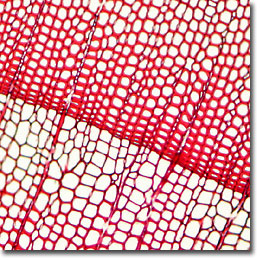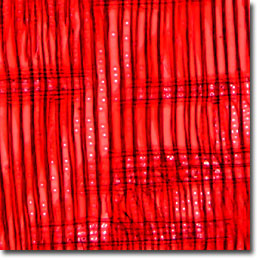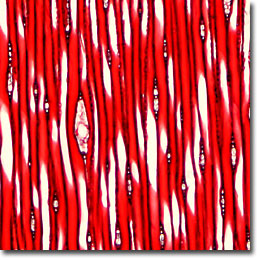The Yellow Pine
The Yellow Pine (Pinus taeda; also known as the Loblolly Pine) is a softwood tree belonging to a group of pines that are collectively referred to as the Southern Pine. This group includes the longleaf, shortleaf, slash, pitch, and pond pines, all members of the Pinus genus. The sapwood ranges from nearly white to shades of yellow and orange-white, while the heartwood is distinct and exhibits hues of yellow, orange, reddish brown, and light brown.

Cross Section

Radial Section

Tangential Section
The pine family (Pinaceae), which contains over 50 species currently in cultivation in the United States, represents a large group of magnificent evergreen species that have tremendous value both as ornamentals and timber trees. Almost all pines have a continuous trunk that displays whorls or tiers of branches, with deviant branches only randomly and rarely appearing outside the whorl. Leaves are needle-like and borne in sheathed clusters of three, growing 6 to 9 inches long on the yellow pine. The cones range 3 to 5 inches in length and have long scales with very sharp points. Although the yellow is not the most beautiful of pine trees, it is tolerant of a wide range of soil conditions, and is seldom seriously affected by insects or diseases. Yellow pines are rapidly growing when young, and can reach a height of 90 feet at maturity.
Chief uses for wood from the southern pine family are pulpwood, hard and particle board, poles, mine timbers, piling, railroad ties, veneer and construction plywood, structural timbers, building construction (all phases), boxes, baskets, mill products, woodenware, novelties, paving blocks, tanks, and silos.
Microscopic examination of iron-alum hematoxylin and safranin stained thin sections (see the digital images presented above) reveals an abrupt transition from spring to summer wood. Tracheids average 35 to 45 micrometers in diameter, and bordered pits occur in a single row or paired on the radial walls. Longitudinal parenchyma is lacking and the rays are of two types: uniseriate and fusiform. Resin canals have thin-walled epithelium and are frequently occluded with tylosoids in the heartwood.